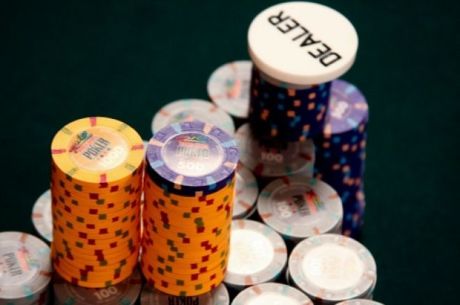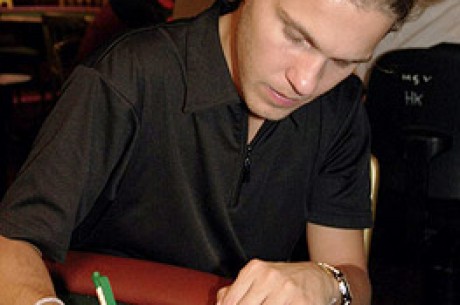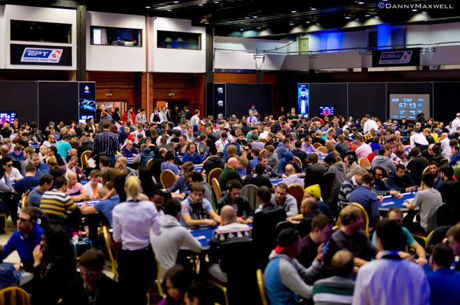"I flopped a nut straight"

In the 1988 World Series of Poker, Johnny Chan and Erik Seidel were heads up (the last two players remaining) in the $10,000 No-Limit Championship Event. In the final hand of the tournament, Chan held Jc-9c and Seidel held Q-7 off-suit. The flop came 8-10-Q of mixed suites. Chan had flopped the nut straight. Erik had a pair of Queens. The turn card, a 3, did not frighten Chan. On the river a 6 fell. Chan had the pure nuts. He checked to Seidel as he did on the turn, slow-playing his nut hand to the river and trying to "**** him in." Chan knew Seidel's style: Seidel frequently went all-in on the river, in an attempt to pick up the blinds, antes and on-the-flop bets. Chan took a gamble that Seidel would make this play again. Sure enough, Seidel moved all-in on the river after Chan checked. Chan "took him down" and successfully defended his title.
The writers of the movie "Rounders" decided to use the film clip of the 1988 WSOP. Sure enough, being another predictable Hollywood film, our hero flops the nut straight on the final hand and makes a Johnny Chan-style slowplay. Of course, he is successful and beats the villain, played brilliantly by John Malkovich. All of this tells us that when you flop a nut straight, you simply check and wait for your opponent to bet all his money to you on the river, when you can raise him and win a massive pot. Unfortunately, limit holdem has certain limitations, so to speak, and in my opinion this play is not correct for a number of reasons.
Nut straights are to be distinguished from nut flushes and full-houses (or better) on the flop, because split pots or bad beats can occur more easily when you flop a nut straight. For instance, when you flop a nut flush (ace high), no one can catch a card to split or improve to a better flush. They must make a full house to beat you. But if you get a free ride in the big blind with a hand like 10-7 and the flop comes 6-8-9, you have flopped the nuts, but a 6, 7, 8, 9, 10, J or Q on the turn will change that fact. In other words, 23 cards in the deck may well make your hand second best. Yet time and time again I see opponents with a nut straight check the flop, simply because they have a nut hand. But given the amount of dangerous cards that may fall, you must bet/raise/reraise/cap in this situation. This is not a time to slow play. Be happy to win a small pot if everyone folds on you. A bet on the flop is unlikely to force a pair or an AK to fold, however a player with a J-X is more likely to fold. However, if you check and give him a free card and it turns out to be a 10, you will not get rid of him. Furthermore, if he improves to a straight it will beat yours.
Therefore, you must protect the pot early in this situation. Not only will you make money from calls on the flop, but you will also force out hands that may pick a draw on the turn, which can consequently beat you on the river. Even if you have J-Q and the flop is 8-9-10 on mixed suits, you should still bet it out. It is true that there are fewer cards to hurt you, but if a player has only three to a flush on the flop, which he would fold for even one bet, but gets a free card and picks up four to a flush, your opponent is unlikely to fold for a bet on the turn and you have inadvertently reduced the number of safe river cards for your hand.
The above example shows how a nut-straight can be cracked or run down more easily than a nut flush and for that reason, one should bet it out and reraise if raised. That is, when you flop a nut flush, only a repeat can present a problem: 9 cards. As we saw above, you can flop a nut straight, but not have the nuts if one of 23 cards falls on the turn. Thus, it is more prudent to slowplay a nut flush rather than a nut straight.
The second reason not to slowplay this hand is to reduce the chance of splitting the pot. Let say you have Q-10 in middle position against three opponents. The flop comes As-Kc-Jd. You have flopped the nuts and no one can make a bigger straight. It would appear that you're in business. But let's say the player on the button has J-10. An earlier position player bets, probably with a pair of aces. If you call, so will the button. If you raise, the button may fold. So let's say you call and the button calls. The turn card is a Queen. Now you still have the nuts, but do not win the pot alone. Rather, you will split it. Furthermore, the button will probably bet or raise on the turn and everyone except you will fold. Now you split a mediocre pot after flopping a nut straight. Hardly a replay of the 1988 World Series. Had you raised the flop, there is a good chance that the player on the button would have folded. Of course, there will always be some players who won't fold no matter what the price is and you can't do anything except charge them when you're in front.
Also, from a financial point of view, the top straight is a good hand to be aggressive with on the flop. In the above example with A-K-J on the flop, you are more like to build a large multi-way pot because several players will have hands such as A-9 and K-J, etc. and will be a lot more willing to put money into the pot, even though they are massive underdogs. The hands you are really trying to get rid of are the 10-8, J-10, Q-9, etc as these are hands that shouldn't be in the pot beyond the flop, but may split the pot is you give them a free or cheap turn card.
It is clear that flopping a nut straight is not a hand you slowplay. Rather you play it very aggressively and obviously. Risking free cards is simply too dangerous. Be happy to win a small one alone, rather than lose a big one or split a mediocre one. Save slowplaying for hands that are bigger than straights.








